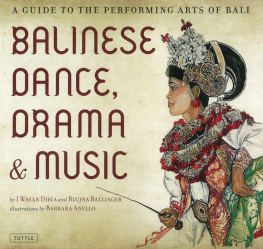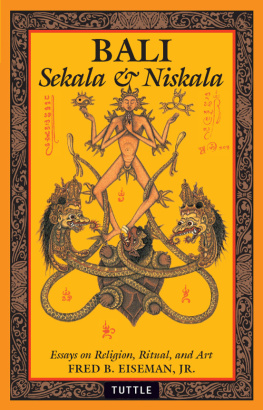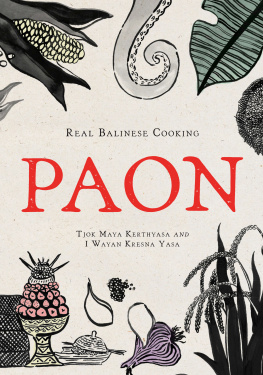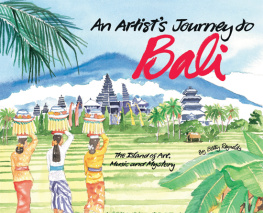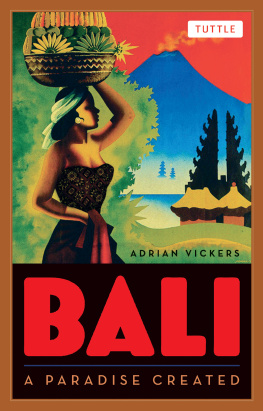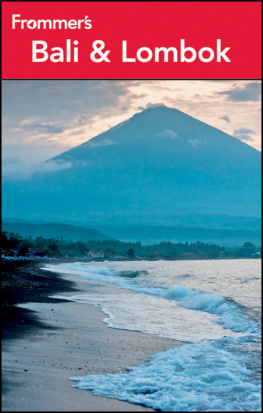Acknowledgments
The authors would like to acknowledge the skills that they have gained from their many teachers. There are so many great Balinese artists that we have studied with that it is impossible to mention them all.
I Wayan Dibia would like to thank his late parents, I Wayan Geriya and Ni Nyoman Rindi (both renowned dancers and his first teachers), the late I Made Kredek (Baris), the late Pande Kenyir (Jauk), the late I Nyoman Kakul (Topeng), the late I Nyoman Kembur (Barong), I Gede Geruh (Gambuh), I Made Jimat (Jauk), I Wayan Beratha (gamelan), I Gusti Bagus Nyoman Panji (former director of the High School of Performing Arts or KOKAR/SMKI), Prof. Dr I Wayan Mertha Sutedja and Prof. Dr I Made Bandem (former directors of ASTI/ISI Denpasar).
Rucina Ballinger began her studies of Balinese dance with I Nyoman Wenten in California and continued with the late I Nyoman Kakul (Baris Gambuh, Topeng), Sang Ayu Ketut Muklin (Legong Keraton), Ni Ketut Arini Alit (Taruna Jay a, Legong Keraton, and other Kebyar dances) and I Ketut Kantor and I Ketut Wirtawan (Topeng). She studied with many great musicians and dancers while an active member of Gamelan Sekar Jaya in California from 1979 to 1985, including her co-author, I Wayan Dibia. To all of the performers in Bali, she extends her warm gratitude. In particular, Arini Alit provided information on Kebyar and Legong, as well as hours of discussion (not to mention laughter). I K. Kantor, I K. Wirtawan, I N. Cerita, I K. Kodi, I. B. Wirjana, I W. Narta and Ni G. A. Raka Rasmin all gave generously of their time. And last, but not least, Agung, Anom and Arie put up with my obsession for many monthsmy heartfelt thanks to my "club of men."
Barbara Anello wishes to acknowledge and thank Ida Pedanda Gede Wayan Datah of Geria Krotok, Budakeling, for his instruction; Ida Wayan Padang and Ida Made Basma of Geria Tubuh, Abang, Karangasem, for the dance; Ida Wayan Taman for his story; Kakiang Belawa and Aji Poleng, gone but remembered; Ida Bagus Dibia, remembered; Anak Agung Raka Bawa, for the first midnight shadow puppet performances; and Alicia Martin and Peter and Barbara Tollitt for adventures shared and kindness shown.
Wayne Vitale gave valuable insight into gamelan music. M. Tenzer, K. Worthy, W. Vitale, J. Diamond, K. Devereaux, P. Yampolsky, E. Herbst, A. Jeanson, A. Timar, K. Tetsuro, D. Myers and R. Brown helped with the compilation of the discography. Barbara Anello read through and edited the manuscript. Garrett Kam, a performer and writer himself, went over the manuscript numerous times, giving generously of his time and knowledge. Our heartfelt gratitude goes to him.
The illustrations are by Barbara Anello and the photographs are from the collections of the authors and illustrator, unless otherwise stated. Any omissions or errors are the fault of the authors and we apologize in advance for these. Our intention is to introduce the beauty of Balinese performing arts to a wider audience.
Mesolah satmaka ngayah ring Sangbyang Widki Wasa
Dancing is like praying to God
Select Bibliography (Works in English)
Bakan, Michael, Music of Death and New Creation: Experiences in the World of Balinese Gamelan Beleganjur, Chicago: University of Chicago Press, 1999.
Ballinger, Rucina, "Dance in Bali: The Passing on of a Tradition in Dance as Cultural Heritage," in Betty True Jones (ed.), Dance as Cultural Heritage, Vol. 2, Selected Papers from the ADG-CORD Conference, NY: Committee on Research in Dance, 1985.
Bandem, I Made, "The Baris Dance," Ethno-musicology, 19: 259-66, 1975.
_____, "The Barong Dance," World of Music, 18(3): 45-52, 1976.
_____, Wayang Wong in Contemporary Bali, Yogyakarta: Bali Mangsi Press, 2001.
Bandem, Made and Fredrik deBoer, "Gambuh: A Classical Balinese Dance Drama," Asian Music, 10(1): 115-27, 1978.
_____, Kaja and Kelod: Balinese Dance in Transition, 2nd edn, Kuala Lumpur: Oxford University Press, 1995.
Belo, Jane, Bali: Rangda and Barong, Monographs of the American Ethnological Society, 16, New York, 1949.
_____, Traditional Balinese Culture, New York: Columbia University Press, 1970.
_____, Trance in Bali, New York: Columbia University Press, 1960.
Coast, John, Dancers of Bali, New York: G. P. Putnam, 1953; reissued as Dancing Out of Bali, Periplus Editions, 2004.
Covarrubias, Miguel, Island of Bali, New York: Knopf, 1937; reprinted Periplus Editions, 2000.
deBoer, Fredrik, "Two Modern Balinese Theater Genres: Sendratari and Drama Gong," in A. Vickers (ed.), Being Modern in Bali: Image and Change, New Haven: Yale Southeast Asia Studies Monograph, 43. 1996.
de Zoete, Beryl and Spies, Walter, Dance and Drama in Bali, London: Faber and Faber, 1938; reprinted Periplus Editions, 2002.
Dibia, I Wayan, "Arja: A Sung Dance-Drama of Bali: A Study of Change and Transformation," Ph.D dissertation, University of California, Los Angeles, 1992.
_____, Kecak: The Vocal Chant of Bali, Denpasar: Hartanto Art Books, 1996.
Eisemann, Fred B. Jr., Sekala and Niskala, Vol. 1: Essays on Religion and Art; Vol. 2: Essays on Society, Tradition and Craft, Singapore: Periplus Editions, 1990.
Emigh, John, Masked Performance: The Play of Self and Other in Ritual and Theater, Philadelphia: University of Pennsylvania, 1996.
Geertz, Hildred, Images of Power: Balinese Paintings Made for Gregory Bateson and Margeret Mead, Honolulu: University of Hawaii Press, 1994.
Herbst, Edward, Voices in Bali: Energies and Perceptions in Vocal Music and Dance Theater, Hanover and London: Wesleyan University Press, 1997.
Hitchcock, Michael and Norris, Lucy, Bali, The Imaginary Museum: The Photographs of Walter Spies and Beryl de Zoete, Kuala Lumpur: Oxford University Press, 1995.
Hobart, Angela, Dancing Shadows of Bali: Theatre and Myth, New York: KPI, 1987.
Hobart, Mark, "Live or Dead? How Dialogic is Theatre in Bali?" in Adrian Vickers and I Nyoman Darma Putra (eds.) with Michele Ford, To Change Bali: Essays in Honour of I Gusti Ngurah Bagus, Denpasar: Bali Post and the Institute of Social Change and Critical Inquiry, University of Wollongong, 2000.
Hooykaas, C , Kama and Kala: Materials for the Study of Shadow Theatre in Bali, Amsterdam: North Holland Publishing, 1973.
_____, The Lay of jaya Prana: The Balinese Uriah, Introduction, Texts, Translation and Notes, London: Luzac, 1958.
Kam, Garrett, Perceptions of Paradise: Images of Bali in the Arts, Ubud: Yayasan Dharma Seni Museum Neka, 1993.
_____, Ramayana in the Arts of Asia, Singapore: Select Books, 2000.
McPhee, Colin, "The Balinese Wayang Kulit and Its Music," in Jane Belo (ed.), Traditional Balinese Culture, New York: Columbia University Press, 1970.
_____, A Club of Small Men, 2nd edn, Singapore: Periplus Editions, 2003.
_____, Music in Bali: A Study in Form and Instrumental Organization in Balinese Orchestral Music, New Haven: Yale University Press, 1966.
O'Neill, Roma S., "Spirit Possession and Healing Rites in a Balinese Village," MA thesis, University of Melbourne, 1978.
Picard, Michel, Bali: Cultural Tourism and Touristic Culture, Singapore: Archipelago Press, 1996.
_____, "Dance and Drama in Bali: The Making of an Indonesian Art Form," in Adrian Vickers (ed.), Being Modern in Bali: Image and Change, New Haven: Yale Southeast Asia Studies Monograph, 43, 1996.
Rai S., I Wayan, Balinese Gamelan Gong Beri, Denpasar: Prasasti Denpasar, 1998.
Ramseyer, Urs, The Art and Culture of Bali, Fribourg: Office du Livre; reprinted Oxford University Press, 1986.
Seebass, Tilman, "Change in Balinese Musical Life: Kebiar in the 1920s and 1930s," in Adrian Vickers (ed.), Being Modern in Bali: Image and Change, New Haven: Yale Southeast Asia Studies Monograph, 43, 1996.

